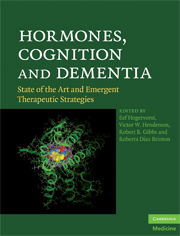Book contents
- Hormones, Cognition and Dementia
- Hormones, Cognition and Dementia
- Copyright page
- Contents
- Contributors
- Preface
- Section 1 Estrogens and cognition: perspectives and opportunities in the wake of the Women's Health Initiative Memory Study
- Section 2 Varieties of estrogenic therapy
- Section 3 Potential modulators and modifiers of estrogenic effects
- Section 4 Possible genetic factors related to hormone treatment effects
- Chapter 15 Possible genetic polymorphisms related to sex steroid metabolism and dementia in women
- Chapter 16 Genetics related to sex steroids: implications for Alzheimer's disease
- Chapter 17 Apolipoprotein E, hormone therapy, and neuroprotection
- Chapter 18 Testosterone, gonadotropins, and genetic polymorphisms in men with Alzheimer's disease
- Section 5 Testosterone, estradiol and men, and sex hormone binding globulin
- Section 6 Gonadotropin effects
- Index
- Plate Section
Chapter 18 - Testosterone, gonadotropins, and genetic polymorphisms in men with Alzheimer's disease
from Section 4 - Possible genetic factors related to hormone treatment effects
Published online by Cambridge University Press: 06 July 2010
- Hormones, Cognition and Dementia
- Hormones, Cognition and Dementia
- Copyright page
- Contents
- Contributors
- Preface
- Section 1 Estrogens and cognition: perspectives and opportunities in the wake of the Women's Health Initiative Memory Study
- Section 2 Varieties of estrogenic therapy
- Section 3 Potential modulators and modifiers of estrogenic effects
- Section 4 Possible genetic factors related to hormone treatment effects
- Chapter 15 Possible genetic polymorphisms related to sex steroid metabolism and dementia in women
- Chapter 16 Genetics related to sex steroids: implications for Alzheimer's disease
- Chapter 17 Apolipoprotein E, hormone therapy, and neuroprotection
- Chapter 18 Testosterone, gonadotropins, and genetic polymorphisms in men with Alzheimer's disease
- Section 5 Testosterone, estradiol and men, and sex hormone binding globulin
- Section 6 Gonadotropin effects
- Index
- Plate Section
Summary
This chapter discusses the possibility that men with Alzheimer's disease (AD) exhibit age-accelerated endocrinological change that increases the risk for AD related pathological processes. This age-accelerated endocrinological change is characterized by an earlier decrease in thyroid stimulating hormone, an earlier increase in sex hormone binding globulin, and a subsequent earlier decrease in free or bioavailable testosterone levels. They also show an earlier increase of gonadotropin levels, which may be an appropriate, if inadequate, response to lower free testosterone levels. However, both these processes (the increase in gonadotropin levels as a response to the lowered levels of free testosterone) have the propensity to negatively affect neuronal health, as subsequent chapters in Section 6 will outline in more detail. This acceleration in age-related endocrinological change may be related to stress and morbidity (which are both known to affect thyroid stimulating hormone) and/or possibly, certain genetic polymorphisms that could predispose to an earlier lowering of free testosterone, which, especially when combined with a decrease of androgen receptors in the brain, leads to a lowered protective environment for the aging brain.
- Type
- Chapter
- Information
- Hormones, Cognition and DementiaState of the Art and Emergent Therapeutic Strategies, pp. 171 - 178Publisher: Cambridge University PressPrint publication year: 2009



